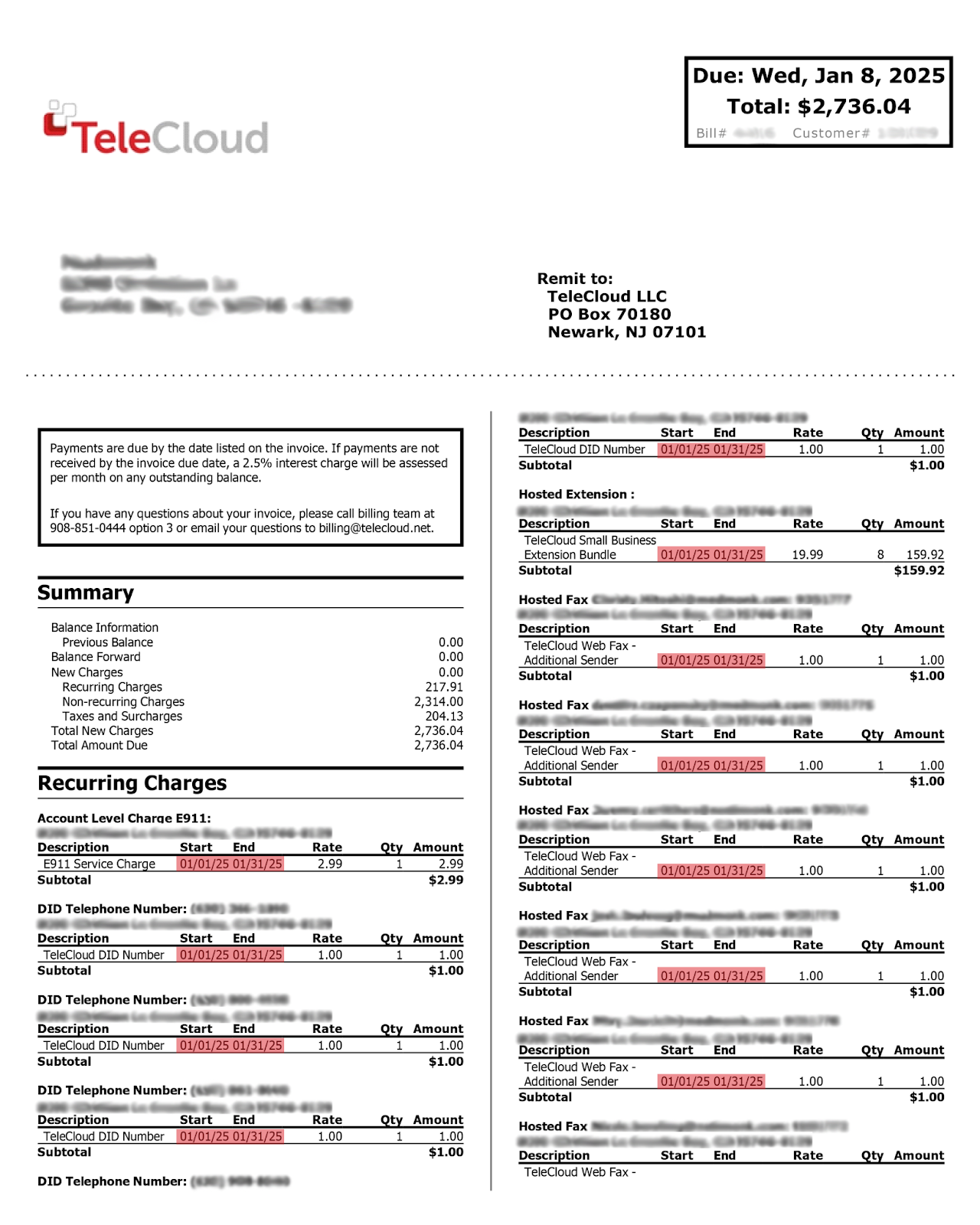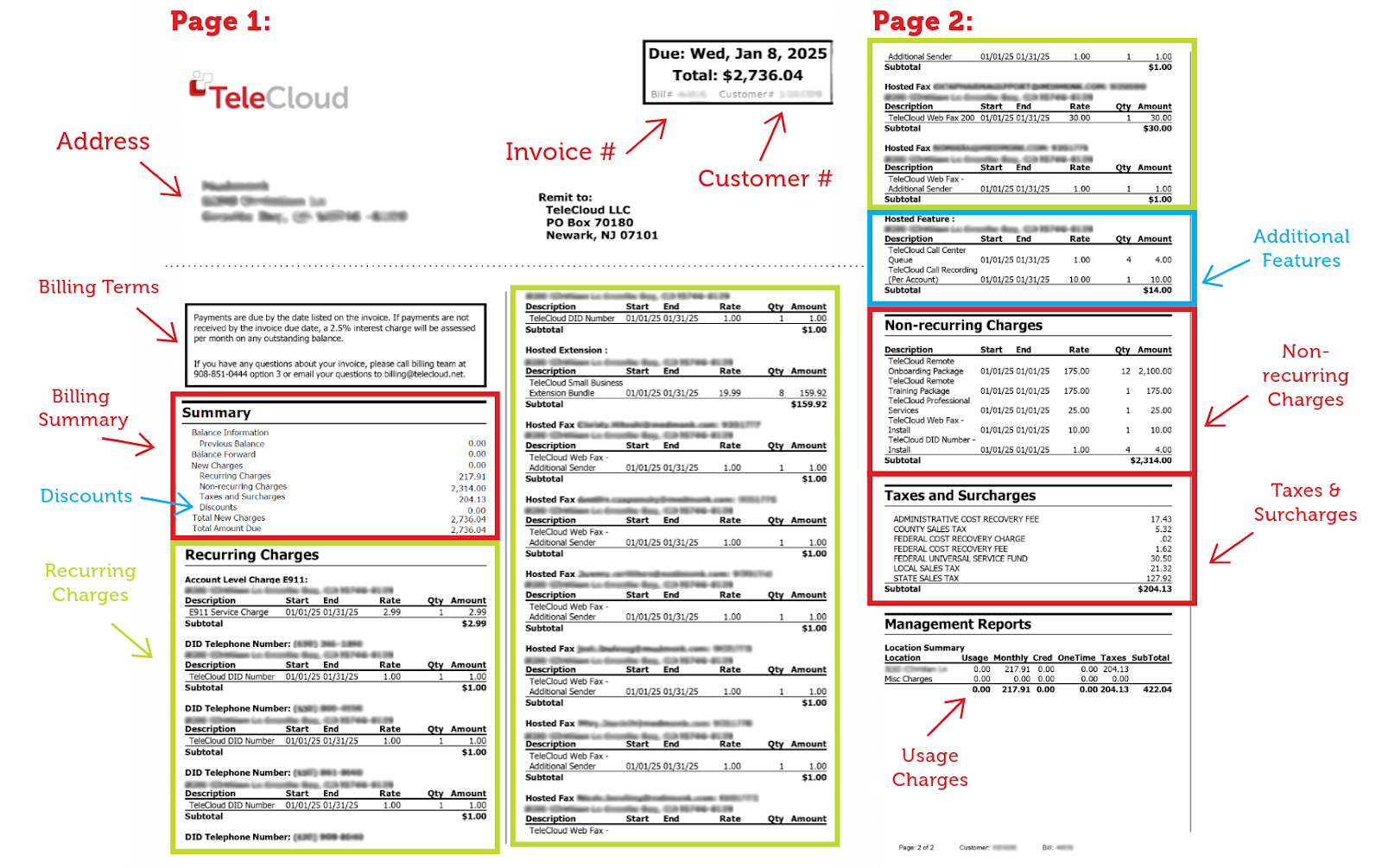How to Read Your First Telecom Phone Bill: A Step-by-Step Guide
Your first phone bill with a new telecom provider can feel like decoding a foreign language. Between pro-rated charges, one-time fees, and taxes you’ve never heard of, it’s easy to feel overwhelmed. Questions like “Why is this higher than expected?” or “What does this charge mean?” are completely normal.
At TeleCloud, we’ve helped countless customers make sense of their telecom bills, and we’re here to do the same for you. With years of expertise in the telecom industry, we know the ins and outs of billing and how to break it down in a way that’s easy to understand.
Your bill doesn’t have to be overwhelming and you deserve to know exactly what you’re paying for! We’ve created this detailed guide to walk you through the key components of your first phone bill, explain why it might look different than expected, and share tips on what to watch for. By the end, you’ll feel confident navigating your invoice and understanding every charge. Let’s dive in!
Why is My First Phone Bill Higher Than Expected? 
Your first invoice might not match the monthly total you were quoted. That’s because it often includes charges you won’t see on future bills. Here’s why:
What are Pro-Rated Charges?
If your service starts mid-billing cycle, you’ll see charges for the remaining days of that cycle plus the next full month. For example, if you start service on the 15th, your bill will include charges from the 15th to the end of the month as well as the following full month. While this is completely normal, it can catch people off guard. Pay specific attention to the dates listed on your bill if the cost seems higher than your monthly agreement (see image).
What are the One-Time Fees on My First Phone Bill?
One-time fees like installation, hardware purchases, or programming costs often appear on the first bill. These non-recurring charges are standard for onboarding and setup, but they’re not ongoing costs.
If you notice these charges appearing on subsequent bills, contact your provider’s billing department to clarify and resolve the issue.
Why are There so Many Taxes and Fees on My Bill?
Telecom services are taxed differently than regular products or services. Expect to see a variety of charges beyond sales tax, including federal, state, and local telecom taxes, as well as fees like FCC and usage taxes.
 How do You Read Your First Phone Bill?
How do You Read Your First Phone Bill?
To help you navigate, here’s a breakdown of the key sections you’ll typically see:
The Front Page: Your Summary
The first page provides an overview of your account and charges:
- Account Details: Includes your name, customer number, invoice number, and billing terms.
- Billing Summary: Shows a high-level breakdown, including:
- Previous balance (if applicable).
- New charges (broken into categories like recurring and non-recurring).
- Total amount due, including any unpaid balances carried forward.
- Contact Information: Provides details on how to reach the billing team with questions.
This page is your go-to summary for understanding the total charges and due date.
Recurring Charges
These are the ongoing monthly costs associated with your phone system:
- Hosted Extensions: Charges for the number of extensions or seats you’re using.
- Hardware Rentals: Monthly fees for rented equipment like phones, switches, or firewalls.
- Additional Features: Charges for services like voicemail, conference bridges, or hosted fax solutions.
Recurring charges typically remain consistent each month, so this section will serve as your baseline for future bills.
Non-Recurring Charges
These are one-time fees for onboarding and setup, such as:
- Installation & Onboarding: Covers physical setup and configuration of your system.
- Training: Covers personalized training sessions to help your team fully utilize the system.
- Programming Fees: Charges for system customization and provisioning.
- Hardware Purchases: Includes phones, headsets, or other devices bought outright.
- Number Porting & DID Numbers: Fees for transferring existing phone numbers to your new system and direct call routing numbers.
- WebFax: Fees for enabling and configuring your digital fax solution.
This section is where most of the first-bill confusion happens, but these charges won’t appear on future invoices.
Taxes and Surcharges
Telecom services are taxed differently from regular products. Expect charges for:
- Federal and State Taxes: Telecom-specific taxes mandated by government agencies.
- FCC Fees: Charges supporting federal telecom regulations.
- Local Taxes: These vary depending on your location.
While these charges might seem excessive, they are regulated by government agencies and do not contribute to TeleCloud's profit.
Usage Charges
Usage charges are variable costs, such as:
- Toll-Free and International Calling: Charges for calls made to toll-free numbers or international destinations.
- LTE Backup Overage Fees: If you exceed your LTE data allotment, those charges will appear here.
Most TeleCloud customers benefit from unlimited domestic usage, so inbound calls may show as $0.
Discounts and Credits
If your plan includes discounts (e.g., promotional pricing or long-term agreements), you’ll find them listed separately in this section. For example, your recurring charge might show as $49.99, but a credit elsewhere will reduce the final amount.
Call Detail Records (CDRs)
For larger accounts, the back pages of your bill may include detailed call logs. These records show:
- Call dates and times.
- Duration and destinations.
- Charges for specific calls (e.g., international or toll-free).
Smaller accounts may not see CDRs by default, but you can request them anytime from the TeleCloud billing team.
How is TeleCloud’s Billing Different from Other Providers?
Unlike other providers, we aim to make your bill as straightforward as possible. Here’s how we keep things simple:
We strive to make your phone bill as transparent and easy to understand as possible. Here’s how:
- Consolidated Billing: All your services—hardware, recurring charges, and usage fees—are included in one invoice.
- Detailed Breakdowns: We separate recurring charges, usage fees, and non-recurring charges so you know exactly what you’re paying for with no hidden fees.
- Proactive Support: If something doesn’t make sense, our billing team is just a call or email away.
Unlike many providers, we often don’t require upfront deposits for installation or onboarding. You’ll only pay once your system is fully set up and ready to go.
What Can You do to Avoid Surprises on Your First Bill?
To make reviewing your first invoice easier:
- Know Your Billing Cycle: Understand the start and end dates to anticipate pro-rated charges.
- Review Your Contract: Familiarize yourself with recurring charges and one-time fees.
- Ask Questions Early: If something doesn’t make sense, don’t hesitate to contact us.
What to Watch for on Future Bills
Once you’ve navigated your first bill, future invoices will feel much simpler. However, keep an eye on:
- Usage Fees: These can vary month to month based on activity.
- Taxes and Surcharges: While consistent, they can fluctuate slightly due to regulatory changes.
What Should You Do if You’re Unhappy With the Cost of Your Telecom System?
Your first phone bill doesn’t have to feel overwhelming. With this guide, you now have the tools to understand each charge and feel confident in what you’re paying for. However, if you find that your bills remain higher than expected or that costs continue to rise without clear explanations, it might be time to reassess your provider.
TeleCloud believes in transparency because we know it builds trust. If your current provider isn’t meeting your expectations, consider exploring your options. Start by checking out our Free Telecom Bill Audit, designed to help you uncover hidden fees, optimize your plan, and potentially save on monthly expenses.
Still have questions about your current bill? We’re here to help. Contact us today, and let’s work together to make your billing experience simple, stress-free, and aligned with your business needs.
It’s likely due to pro-rated charges, which include both the remaining days of your billing cycle and the next full month. One-time fees like installation or hardware costs may also contribute.
Refer to the contact information on the first page of your bill. You can reach TeleCloud’s billing team by email or phone to resolve discrepancies quickly.
Discounts are often listed as separate credits rather than being deducted from the initial charge. Look for a line item labeled “TeleCloud Discount” or similar.
No, unless bundled as part of your plan. Internet service is typically billed separately by your ISP.
For services like LTE backup or international calling, overages will appear as usage charges. Monitoring your usage can help you avoid unexpected costs.
We’ll pro-rate your final bill, ensuring you only pay for services used.
